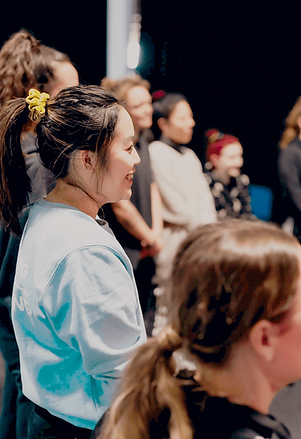Bulletproof Your Ankles: Key Exercises for Strong, Stable Ankles (Mid-Stage Rehab)
- Bethany Shum

- Apr 26
- 3 min read
Ankle sprains are one of the most common injuries in sports and performance settings.
Whether you're a gymnast, cheerleader, tumbler, aerialist, or performer, chances are you've either experienced one yourself - or watched a teammate hobble off the mat. In this blog, we're breaking down simple ways to assess your ankle mobility and strength, and sharing practical exercises you can try at home or in your training space to help build strong, stable ankles and prevent future injuries.
🦶 Understanding the Ankle Joint
The ankle is a hinge joint, which means it’s designed to move up and down (dorsiflexion and plantarflexion). But when you’ve had an ankle sprain—especially one affecting the outer ankle (the most common type)—you can develop swelling, stiffness, and a loss of proper mobility.
One way to check for lingering tightness or imbalance is by using a visual and hands-on assessment:
Compare left vs. right ankles for any signs of swelling.
Feel around the joint—especially the front and sides—for stiffness.
Notice if one ankle has more of a “crease line” than the other, which may be a sign of swelling or restricted movement.
🧪 Quick Self-Tests You Can Try
1. Seated Dorsiflexion Test
Sit on a chair and try lifting your toes toward your shins. Do both sides feel equally strong? If one is harder than the other, that might point to muscle imbalance or stiffness.
2. Knee-to-Wall Test
Stand in front of a wall with one foot flat on the ground and your toes about 5–10 cm away. Try bringing your knee forward to touch the wall without your heel lifting.
Measure the distance from your toes to the wall. If there’s a noticeable difference between your ankles, you might have reduced dorsiflexion on one side.
🔁 Mid-Stage Rehab Exercises for Ankle Recovery
If you're already walking and performing daily activities but your ankle still feels stiff or unstable, here are a few key exercises to include in your routine:
1. Band-Assisted Mobilisation (for Dorsiflexion)
Wrap a resistance band around the front of your ankle joint (just above the talus), anchor the other end behind you, and gently lunge forward.
This helps encourage proper gliding of the ankle joint and can reduce front-ankle tightness after a sprain.
2. Heel Raises with Ball Squeeze
Place a small ball between your ankles, rise up onto your toes, and lower down slowly—without dropping the ball.
This activates your calf muscles and the stabilisers around your ankle.
Make it harder: Try to use your knees slightly bent to target deeper muscles like the soleus.
3. Single Leg Balance + Throw & Catch
Stand on one foot and toss a small ball or object side to side or forward and back.
This challenges your balance, coordination, and proprioception—all important for ankle stability.
4. Wobble Board Reach Drill
Use a wobble board or an unstable surface. While standing on one leg, use your free leg to reach in multiple directions:
Forward
Backward
Side-to-side
Clockwise and counterclockwise
This builds dynamic control and reaction time, making your ankles more resilient in real-world situations.
🧠 Final Thoughts
Mid-stage rehab is where most athletes and performers get stuck—feeling “okay” but not yet confident or strong enough to return fully. These exercises are designed to bridge that gap, helping you rebuild strength, improve control, and reduce your risk of re-injury.
If you're dealing with ongoing stiffness or instability, it’s worth checking in with a physio to create a plan tailored to your performance goals.
Stay strong, stay grounded—and keep those ankles bulletproof. 💪
Want more recovery tools for performers?
Visit www.fmphysio.com or follow us on Instagram @flexibility_matters



.png)





Comments